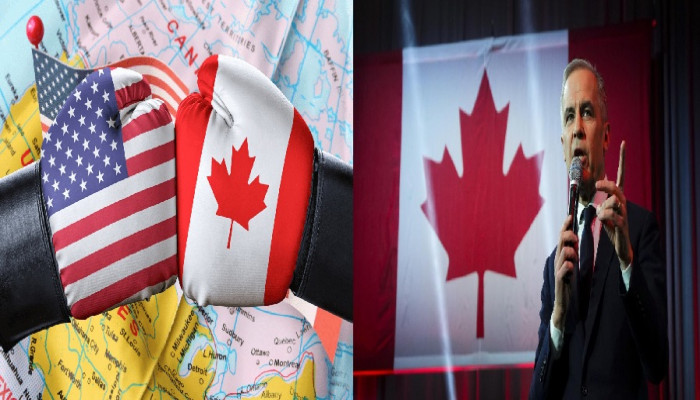Navigating the Canada–U.S. Trade War: Remedial Options for PM Mark Carney
- In Foreign Policy
- 11:41 AM, Sep 26, 2025
- Dr. Vineet Singh & Dr. A. Adityanjee
Introduction
In these tumultuous times in geopolitics, the most publicised trade war unleashed by the US President Trump has been against neighbouring Canada, a historically very close strategic and economic partner.
Till now, Canada has been one of the top two trading partners for the United States. The two countries share a long history of supply chain integration, especially in the automotive and textile industries and the energy sector. The integration of supply chains and trade became more integrated with the NAFTA in the 1990s and its successor agreement, CUSMA, which Trump renegotiated during his first term.
Most recently, in 2024, Canada was the top destination for U.S. exports and the third-largest source of U.S. imports. Canada exported over three-quarters of its goods to the United States and imported almost half of its goods from the United States.
Background:
Even before the start of his second term, Donald Trump started to destabilise Canada by lampooning former Prime Minister of Canada Justin Trudeau as Governor Trudeau of the great 51st state of Canada. That was not merely a facetious joke but a serious attempt to derail Canada’s economic survival, leading to the collapse of the state and eventual merger with the US that Trump wants on “security and strategic reasons”. Trump’s trolling and hounding of Trudeau had political consequences in Canada, leading to the resignation of Trudeau as the liberal party leader, early national elections and loss of the Conservative Party, which were predicted to win the national elections by wide margins in earlier opinion polls. While Canada faces economic headwinds from the US, Canada’s rich source of revenue from Indian students and tourists is dwindling because of bilateral problems triggered by Justin Trudeau’s impulsive and outlandish claims and tirades against India without any hard-core evidence. Trudeau’s claim of “Credible” allegations based on unsubstantiated intelligence from the Five Eyes Alliance over the killing of Hardeep Singh Nijjar prompted reciprocal diplomatic expulsions. Diplomatic scuffle caused a sharp reduction of envoys in 2023 and a significant deterioration in bilateral ties.
US-Canada Trade Summary
The United States’ leading exports to Canada are vehicles, machinery, and energy products, along with over $30 billion in agricultural products, including bakery goods, cereals and pasta, fresh vegetables, fruit, and ethanol. Canada’s leading exports to the United States are energy products and vehicles, together with over $40 billion in agricultural products, including baked goods, cereals and pasta, vegetable oils, beef and beef products, processed fruit and vegetables, and fresh vegetables.
The United States and Canada, together with Mexico, are parties to the United States-Mexico-Canada Agreement (USMCA), which entered into force on July 1, 2020, after strong objections were raised on the previous version of the North American Free Trade Agreement (NAFTA) by Donald Trump during his first term as US President.
U.S. goods and services trade with Canada totalled an estimated $909.1 billion in 2024.
U.S. total goods trade with Canada was an estimated $761.8 billion in 2024. U.S. goods exports to Canada in 2024 were $349.9 billion. U.S. goods imports from Canada in 2024 totalled $411.9 billion. The U.S. goods trade deficit with Canada was $62.0 billion in 2024.
U.S. total services trade (exports plus imports) with Canada totalled an estimated $147.3 billion in 2024. U.S. services exports to Canada in 2024 were $90.3 billion, up 4.5 per cent ($3.9 billion) from 2023. U.S. services imports from Canada in 2024 were $57.0 billion.
The U.S. services trade surplus with Canada was $33.2 billion in 2024.
US Canada Tourism Revenues
- In 2019, over 15 million Americans visited Canada, making it a top international destination.
- Canada welcomed approximately 10 million visitors from the US in 2020, a significant drop due to the pandemic.
- The tourism sector in Canada contributed around CAD 105 billion to the economy in 2019.
- Outdoor activities, cultural experiences, and urban tourism are major attractions for US travellers in Canada.
- The average spending per US visitor in Canada was about CAD 1,500 in 2019.
- Post-pandemic recovery is underway, with increasing travel interest and easing of restrictions.
The volume of Canadians taking road trips into the U.S.—the means by which most Canadians visit—dropped by 33% last month compared to June 2024, according to new data from Statistics Canada, following a 38% drop in May. There was also a 22% decline in air travellers from Canada year-over-year. June was the sixth consecutive month of steep declines in inbound Canadian travel, including double-digit year-over-year drops in car travel and air travel to the U.S. every month since April. This tourism boycott by Canadians is likely to cause an expected overall economic loss of $29 billion in 2025 for the American tourism industry. Travel in the other direction is also down, as fewer Americans travelled to Canada in June compared to last year, with car travel down 10% last month—down slightly from an 8% drop in May, per Statistics Canada data.
Scenario Post President Trump 2.0
Obviously, the eruption of this trade war between Canada and the United States in 2025 has ruptured North America’s tightly woven economic ties.
Sweeping U.S. tariffs on Canadian steel, aluminium, autos, and agricultural products prompted Canada to retaliate with counter-tariffs on $30 billion of U.S. imports. The result has been heightened uncertainty for businesses, supply-chain disruption, and political friction across the world’s longest undefended border.
To make matters worse the most recently with a new Executive Order from the White House, the U.S. then decided to increase tariffs on non-CUSMA (Canada–United States–Mexico Agreement) compliant goods imported from Canada, from the current 25% to 35%, from August 1.
President Trump, in his Executive Order, attributed to increase to insufficient cooperation in curbing the flow of fentanyl and other illicit drugs into the U.S., as well as retaliatory actions taken by Canada.
For Prime Minister Mark Carney, the first Canadian leader to take office with deep financial and central banking experience, the crisis is both a test of statecraft and of economic management. It would not be incumbent upon Canada to defend its national interests without risking a spiral of escalation that could damage jobs, erode competitiveness, and undermine confidence in the rules-based trading order eventually.
What are the options for Canada?
It is hard to predict if this is going to be the new world order or if things will change post-President Trump 2.0. However, given the divisive politics at play, Canada will have to think long-term. This article, therefore, tries to reflect on some remedial options—immediate, medium-term, and long-term—that the Carney government can deploy to navigate the crisis while building future resilience.
The Stakes of the Dispute
Just to reiterate the background, the Canada–U.S. economic relationship is uniquely interdependent. Roughly three-quarters of Canadian exports go to the United States, while Canada is the second-largest market for U.S. goods and services. Key industries—autos, aerospace, energy, and agri-food—rely on cross-border supply chains that blur the line between “Canadian” and “American” production.
A trade war disrupts not only exporters but also manufacturers, workers, and consumers on both sides. The immediate risks for Canada include:
- Job losses in export-dependent sectors. Steel, aluminium, and auto production are heavily concentrated in Ontario and Quebec, making them politically sensitive.
- Supply-chain dislocation. Tariffs on intermediate goods affect downstream industries that rely on just-in-time cross-border inputs.
- Investor uncertainty. Tariffs erode predictability, leading firms to defer investment decisions.
- Political polarisation. Domestic divisions may deepen if some provinces bear disproportionate costs.
Against this backdrop, the Carney government must balance firm defence of Canadian industries with pragmatic diplomacy to restore stable trade relations.
Immediate Remedial Options (0–30 Days)
Businesses will need emergency economic relief; the government will need to start urgent diplomatic engagement, trade talks, and lastly prepare for legal challenges under USMCA and WTO
Short-Term Strategy (1–6 Months)
In the next few months, there needs to be ongoing negotiation with leverage, internal political forces and coalition partners would need to be engaged to strategise targeted industrial policy with monetary and fiscal coordination.
Medium -Term Resilience (6–24 Months)
1. Export Diversification
The trade war underscores the danger of overreliance on a single market. Canada should accelerate diversification toward Asia, Europe, and Latin America. This requires not only trade missions but also structural investment in logistics, digital trade, and regulatory harmonisation with alternative partners. Having a long-term strategy which is inclusive across the spectrum, involving all political stakeholders and parties, will help. It should not be a refuge for one government.
Indo-Canadian strategic cooperation can go a long way in offsetting the Canadian trade deficit and open newer opportunities.
Canadian investment in India remains strong, particularly through pension funds that have invested heavily in infrastructure and energy. These investments have continued despite diplomatic challenges, with Canadian portfolio investments in India estimated to exceed US$75 billion. Over 600 Canadian companies operate in India, and more than 1,000 are active in various capacities across the Indian market.
The resumption of free trade agreement (FTA) negotiations and efforts to normalise ties between the two nations present a strategic opportunity for New Delhi to diversify its supply of critical minerals, including lithium, nickel, cobalt, graphite, and rare earth elements. With China imposing curbs on key mineral exports such as rare earth magnets, India faces mounting pressure to identify alternative, dependable sources to fuel its rapidly expanding EV, solar energy, and electronics sectors.
Canada, which exported over US$50 billion worth of critical minerals in 2023—primarily to the U.S.—is emerging as a promising partner. It holds reserves of more than 31 critical minerals and is known for its environmentally and socially responsible mining practices.
India currently depends heavily on China for essential minerals, importing 71% of lithium and 42% of rare earth imports. In contrast, Canada accounts for just 0.13% of lithium and 0.02% of rare earth imports to India, according to the Asia-Pacific Foundation of Canada.
Canada’s massive mineral reserves can be a potential alternative. Just to put it in context, in 2024, Canada exported $5 billion of goods to India and imported approximately $8 billion worth. Indian imports of Canadian goods represent approximately 0.7 per cent of Canada’s goods exports, making India the tenth-largest buyer of Canadian products.
- Canada’s principal exports to India consist of agricultural products, specifically dried legumes, and energy products, coal, as well as wood pulp and fertilisers.
- Meanwhile, Canada’s principal imports from India consist of pharmaceuticals, machinery, both nuclear and electronic, as well as several classes of consumer goods, including jewellery and clothing. The trade war between India and the US presents huge opportunities to diversify and expand in jewellery and clothing, which is being hit the most by the US’s trade tariffs against India.
- Political tensions had strained diplomatic relations, though despite this turbulence in the relationship, trade between the two nations had remained relatively stable and largely free of any punitive restrictions.
Long-Term Resilience: (Post 24 months)
So as to deal with an unreliable, economic and trade partner US, both Canada and India must minimise their diplomatic differences that cropped up during the Justin Trudeau regime. Canada needs to detach itself from the “Five-Eyes Alliance” to counterbalance US economic hegemony and give more emphasis to India’s security concerns about state support to Canadian-based terrorist organisations and individual Canadian citizens who are creating mayhem in some of the Indian states. If both countries can repair the diplomatic relationship and turn the trade crisis into an economic opportunity, it will be a win-win situation for both and a serious lesson for Uncle Sam.
India is a rising giant:
- India’s population of 1.4 billion people has the fourth largest nominal GDP, can provide a vast consumer base for Canadian exporters, with over 1.8 million Canadians of Indian origin, serving as a bridge between the two nations.
- A quarter of Canada’s exports to India are dried legumes. In 2017, India imposed tariffs on Canadian exports of legumes to protect domestic production. These tariffs were lifted in 2023, and exports of this product have since rebounded. Given the country’s growing urban population, food demand is set to rise, providing opportunities.
- There is a huge scope to grow exports of petroleum oil and natural gas.
- Exports of fertilisers, including potash, to India have grown over the last two decades. In 2022, Indian Potash Limited signed a memorandum of understanding with Canpotex, Canada, outlining an agreement to supply up to 1.5 million tonnes of potash annually for a period of 3 years to Indian fertiliser companies. Given India’s sizable agricultural sector, demand for Canadian fertilisers continues to offer good growth potential.
- India imported gold worth just over 50 billion USD in 2024. Widespread economic uncertainty has driven gold prices to record highs in recent months. Supported by a buoyant price outlook, Canadian gold production is on an upward trend, and India is an important destination for the precious metal.
A Look Ahead
- Looking ahead, India remains an attractive export market, but the product mix is shifting. Demand for coal is set to taper, while demand for Canadian critical minerals is likely to rise, behind strong demand from India and large reserves in Canada. Nickel is a prime example of a rapidly growing critical mineral export, with its value having doubled over the past decade.
- India’s digital economy is growing much quicker than the overall economy. According to estimates by the Indian Council for Research on International Economic Relations (ICRIER), the digital economy is projected to account for 20 per cent of national income by 2029. This means services trade, both in imports and exports, will play an increasingly important role in the trading relationship moving forward.
- In a time of rising U.S. protectionism and ongoing trade disputes with China, a trade deal with India would allow Canada to diversify its export portfolio and gain greater access to rapidly growing consumer demand.
- Indian demand for Canadian agricultural products, including food and fertilisers, will remain a cornerstone of bilateral trade.
- India’s natural gas consumption is projected to increase by 60 per cent between 2023 and 2030, according to the International Energy Agency. This surge in demand is expected to double the country’s LNG import requirements, as domestic production is expected to grow at a much slower pace.
- The share of petroleum oil exported to countries other than the United States rose notably in 2024. While China is the largest buyer, there are signs of growing Indian interest. In 2024, the Indian energy multinational, Reliance Industries, purchased 2 million barrels of Canadian crude, the first shipment from the Trans Mountain pipeline. Urbanisation and a growing middle class in India will see per-capita energy consumption grow, presenting an opportunity for increased exports of Canadian petroleum to India.
- Canada is now making amends in its diplomatic behaviour and in June 2025, Mark Carney met PM Modi on the sidelines of the G7 summit in Canada, opening a new phase in the bilateral relationship. India’s new High Commissioner to Canada, Dinesh Patnaik, formally assumed office in Ottawa, further signalling efforts to restore normalcy in relations. India also indicated the possibility of reinstating Canada’s full diplomatic presence. The National Security Advisor, who previously accused Indian officials of involvement in terror activities, visited New Delhi and met with India’s NSA. Canada recently arrested a Sikh-Canadian citizen, Inderjeet Singh Gosal, who was accused of terrorist activities in India.
- Canada’s National Security and Intelligence Advisor, Nathalie G. Drouin, recently visited New Delhi and issued the following statement:
“Thursday in India, I met with Mr. Ajit Doval, India’s National Security Advisor. We discussed our respective security concerns and committed to non-interference, including refraining from transnational repression. We also agreed on the importance of reciprocal exchange of information and mutual responsiveness. This meeting followed constructive discussions held between Prime Minister Carney and Prime Minister Modi at the G7 Leaders’ Summit in Kananaskis, Alberta, during Canada’s G7 presidency year. With these talks, and the recent exchange of high commissioners between Canada and India to renew the diplomatic relationship, we are advancing a relationship based on mutual respect, the rule of law, and a commitment to the principle of sovereignty and territorial integrity.”
- Canadian Foreign Minister Anita Anand is scheduled to visit New Delhi next month to repair the bilateral ties.
Summary
Mark Carney entered politics with a reputation as a technocrat who could steady turbulent markets. Now, as Prime Minister, he faces a political and economic crisis of continental significance. The trade war demands both firmness and pragmatism: defending Canadian industries without allowing the dispute to spiral into a lose-lose confrontation.
The most effective approach is a two-track strategy: pursue active negotiations in good faith while preparing credible countermeasures and legal challenges. This reassures businesses that Canada is defending their interests, signals to allies that Canada remains a champion of rules-based trade and makes clear to Washington that Canada will not be an easy target.
In the short term, emergency relief and precise diplomacy can prevent irreversible damage. In the medium term, coalition-building and targeted industrial policies can shift the balance of leverage. In the long term, export diversification and domestic value-added strategies can lessen Canada’s structural vulnerabilities.
The risks of escalation are real, but so are the opportunities. Managed wisely, this crisis could become a catalyst for Canada to build a more resilient, diversified, and competitive economy. For Prime Minister Carney, the trade war is a daunting test—but also a defining moment to shape Canada’s economic future. As discussed above, the India-Canada partnership will be a game changer with India’s humongous market, the fastest growing major economy with a pool of skilled workforce and Canada, the cradle of rich natural resources and technologies in many important sectors. A famous quote by Albert Einstein is relevant here: Learn from yesterday, live for today, hope for tomorrow. The important thing is not to stop questioning.







Comments